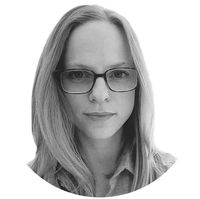How to network on a flight the right way
Part of our series on how to be a better traveler


In 2005, New York entrepreneur Peter Shankman launched a website that was way ahead of its time. AirTroductions, as the site was called, had one purpose: let air travelers choose their seatmates.
"I was always sitting next to really annoying people, for months on end," Shankman says. "And then it occurred to me: Why can't we connect with the people we sit next to on airplanes the way we do in real life?"
AirTroductions did just that, letting travelers log in with their flight information and choose who they wanted for a neighbor for the next several hours, whether that be a friend or a potential client. The site didn't last long, however, and was eventually acquired.
The Week
Escape your echo chamber. Get the facts behind the news, plus analysis from multiple perspectives.

Sign up for The Week's Free Newsletters
From our morning news briefing to a weekly Good News Newsletter, get the best of The Week delivered directly to your inbox.
From our morning news briefing to a weekly Good News Newsletter, get the best of The Week delivered directly to your inbox.
But AirTroductions was onto something: using otherwise idle time spent up in the air to make valuable connections. Today, several airlines are launching their own tools and apps to facilitate in-flight networking. And indeed, with business travel booming, "socializing in the sky is here to stay," says The Economist.
But what are the rules for approaching someone at 35,000 feet? If you want to take advantage of your time in the clouds to pad your rolodex, here are a few helpful tips.
Step 1: Find out who's on your plane
There are a few good apps you can use to facilitate this process. Last year, Virgin America unveiled its in-flight networking app called Here on Biz. It allows business travelers to connect through LinkedIn and "quickly see which of your contacts are around you, keep tabs on your colleagues as they travel about, and get introduced to new professionals of interest in your vicinity." The downside, of course, is it only works for Virgin America flyers.
A free daily email with the biggest news stories of the day – and the best features from TheWeek.com
[[{"type":"media","view_mode":"media_original","fid":"121273","attributes":{"alt":"","class":"media-image","height":"568","style":"display: block; margin-left: auto; margin-right: auto;","typeof":"foaf:Image","width":"320"}}]](Courtesy Photo)
If you're a Delta devotee, the airline recently partnered with LinkedIn to launch Delta Innovation Class, an in-flight mentoring program that connects top-notch experts in business and technology with "up and coming doers and innovators." Business-minded travelers can apply to sit with these experts on flights to big events (the first trip was to the 2014 TED conference).
As for non-airline specific apps, there's Quicket, which connects with popular social networks and lets you opt in to display your seat and identity to fellow travelers. "Since you are all on one plane, you have an opportunity to meet people with similar interest," says Djois Franklin Sronipah, cofounder of Quicket. Of course, as Paul Sawers at The Next Web notes, "this relies entirely on others on your flight using Quicket, which will make this feature redundant in many respects, certainly until Quicket garners more users."
For his part, Shankman uses TripIt to see who's flying with him. He also uses Twitter to broadcast his flight info and see if anyone will be on the flight or in the airport. He's also done this on roadtrips. "Back in October I was driving from Phoenix to San Diego and I tweeted 'Hey guys, driving from Phoenix to San Diego on I8, anyone wanna meet up on that route for coffee?' I wound up meeting with two people."
If the high-tech options don't work, there's always good, old-fashioned, in-person mingling. Find a common area, if possible, and make your move. "Yesterday I was just flying to Dubai and back on the big A380 plane and there was a whole area on the bottom floor where people can talk," Sronipah says. "You could go there and see who you meet, go to bar and have a discussion."
Step 2: Gauge if they want to talk to you
Many people don't see flying as a networking opportunity. They'd prefer to sleep, read, or otherwise not be bothered. Indeed, Shankman says the top request on AirTroductions was from people wanting to sit next to someone who wouldn't talk to them at all. "I do my best thinking when I'm on the plane," says Cemal Ozdemir, who works at an accounting firm and flies about 150,000 miles a year. "If someone's gonna talk to me I'll be like, 'Ugh!'"
How do you know if networking is an option in your case? It's not hard: Use your common sense. "Headphones are the universal symbol for 'stay away from me, I don't wanna talk,'" Shankman says. So look for the people with seemingly nothing else to do. "If there's a person sitting on a plane not doing anything, they're looking for an excuse to talk to you."
Step 3: Break the ice
"On a plane, chances are you have a common enemy and that is the airline," Shankman says. "If you're delayed and miserable, there's your common enemy to start with." While Ozdemir says most of the time he prefers not to talk at all on a flight, when he does, it's because of something happening with the flight. "Sometimes I'll sit there and the pilot will say something weird and I'll look at my neighbor and go, 'What was that?' and then this starts the conversation."
Step 4: Follow up
If you make new connections in the air, be sure to leave a business card or get their contact information before de-planing. Shoot them an email and say "thanks" for the interesting conversation. Maybe even meet up for coffee after you reach your destination. You never know when it might pay off.
"I've made tons of valuable connections on flights," Shankman says. "I've met people on planes I've wound up doing speeches for. I've met people I've dated. I find it fun, I enjoy it."
Jessica Hullinger is a writer and former deputy editor of The Week Digital. Originally from the American Midwest, she completed a degree in journalism at Indiana University Bloomington before relocating to New York City, where she pursued a career in media. After joining The Week as an intern in 2010, she served as the title’s audience development manager, senior editor and deputy editor, as well as a regular guest on “The Week Unwrapped” podcast. Her writing has featured in other publications including Popular Science, Fast Company, Fortune, and Self magazine, and she loves covering science and climate-related issues.
-
 Venezuela’s Trump-shaped power vacuum
Venezuela’s Trump-shaped power vacuumIN THE SPOTLIGHT The American abduction of Venezuelan President Nicolás Maduro has thrust South America’s biggest oil-producing state into uncharted geopolitical waters
-
 Most data centers are being built in the wrong climate
Most data centers are being built in the wrong climateThe explainer Data centers require substantial water and energy. But certain locations are more strained than others, mainly due to rising temperatures.
-
 ‘Maps are the ideal metaphor for our models of what the world might be’
‘Maps are the ideal metaphor for our models of what the world might be’Instant Opinion Opinion, comment and editorials of the day
